Terry Lovejoy's new comet has gone from faint to bright in just three weeks and is now a tempting binocular target at dawn.
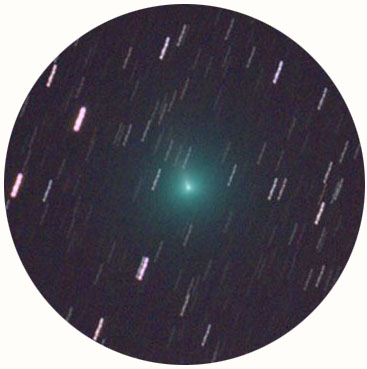
Terry Lovejoy
Who doesn't love a comet that exceeds expectations? That's exactly what's happening with Terry Lovejoy's latest discovery, C/2017 E4 Lovejoy. Discovered on March 10th at magnitude +12, early observations suggested a peak magnitude of +9 in mid-April, assuming it didn't crumble apart en route to an April 23rd perihelion.
Forget that. This fuzzball's already magnitude +7–7.5 and a snap to see in 50-mm binoculars. I know because I got up Wednesday morning (March 29th) shortly before the start of dawn, pointed my 10×50 glass just below the figure of Equuleus, the Little Horse, and saw a small, dense ball of glowing fuzz without even trying. Comet 41P/Tuttle-Giacobini-Kresak — now circumpolar in Ursa Major — shines at a similar brightness, but being larger and less condensed, it's not quite as easy to see as Lovejoy.
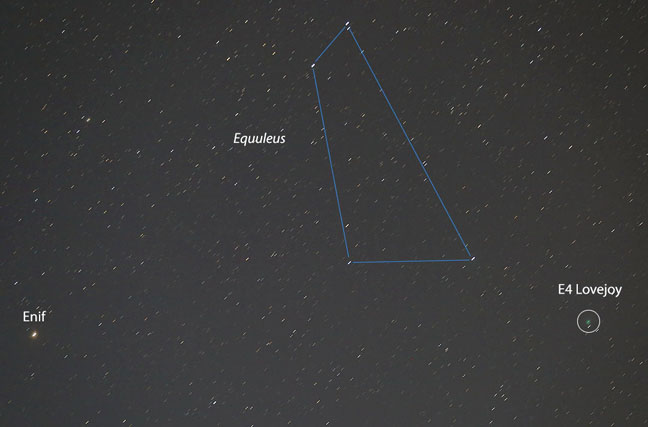
Bob King
A little more than a week ago, Comet Lovejoy glowed at magnitude +10–11; a few days ago it was at +9. Given its meteoric rise in brightness, observers are anticipating the comet to crest to magnitude +6 around perihelion as it describes a roller coaster arc across Pegasus and Andromeda. Twice it passes bright deep-sky objects: the bright globular cluster M15 on April 1st and the Andromeda Galaxy on April 20–22. Another easy time to spot it will be on April 8–9 alongside β Pegasi in the northwest corner of the Great Square.
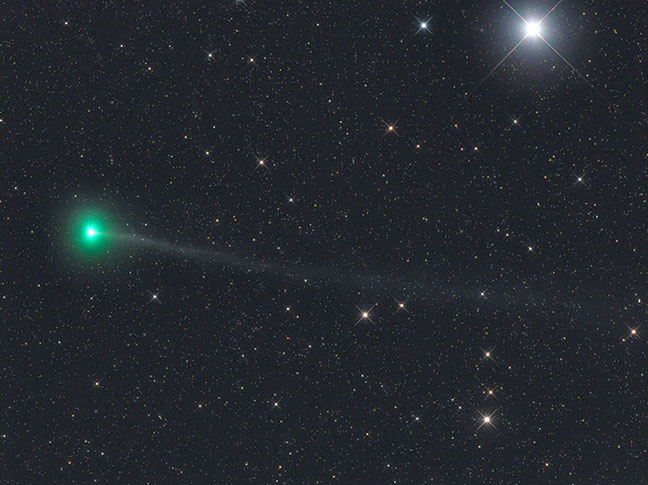
Gerald Rhemann
With the Moon out of the picture until around April 7th, comet watchers have lots of dark-sky time to pursue this new find. Just remember that you'll only have a relatively short time before the start of dawn, when the comet is highest in the eastern sky. Because of increasingly early sunrises, Lovejoy maintains a fairly constant 15° elevation at the start of morning twilight from mid-northern latitudes through mid-April. My observation was made at 5 a.m. about 10 minutes before dawn's first light. Look for a small, fuzzy spot that appears at first glance like an out of focus star.
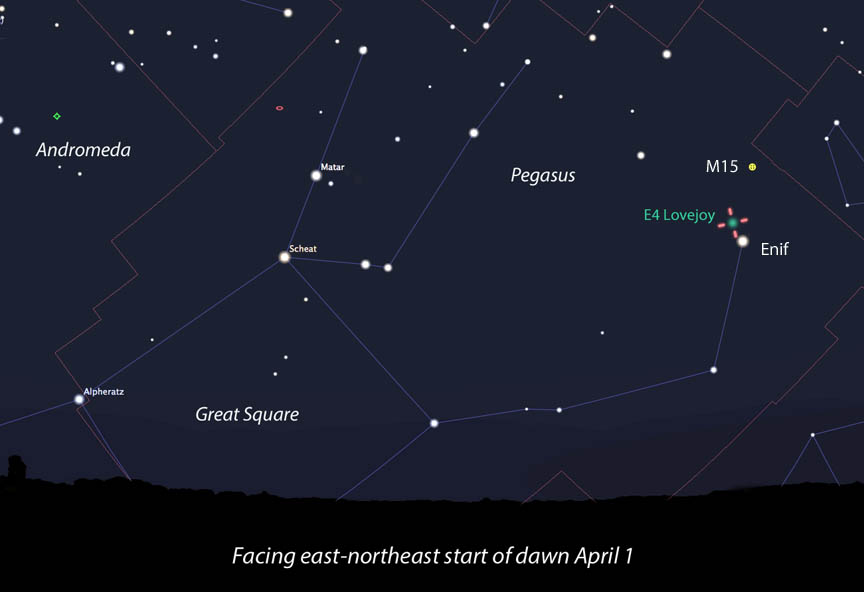
Stellarium
Already the comet's developing jet-like structures within the coma and a narrow gas tail. Through my 10-inch telescope on March 29.4 UT, the bright, compact coma measured 5′ across with a hint of blue from fluorescing gas.
Recent images show the coma as oval or "flattened." This is also obvious visually through the telescope with Lovejoy resembling a bright elliptical galaxy. When you seek the comet, note the coma's shape and color and the visibility of the newly-emerging, west-pointing tail. Amateur Chris Wyatt of Australia reports that a Swan Band filter enhances the comet's visibility. I gave it a try and it made the comet pop.
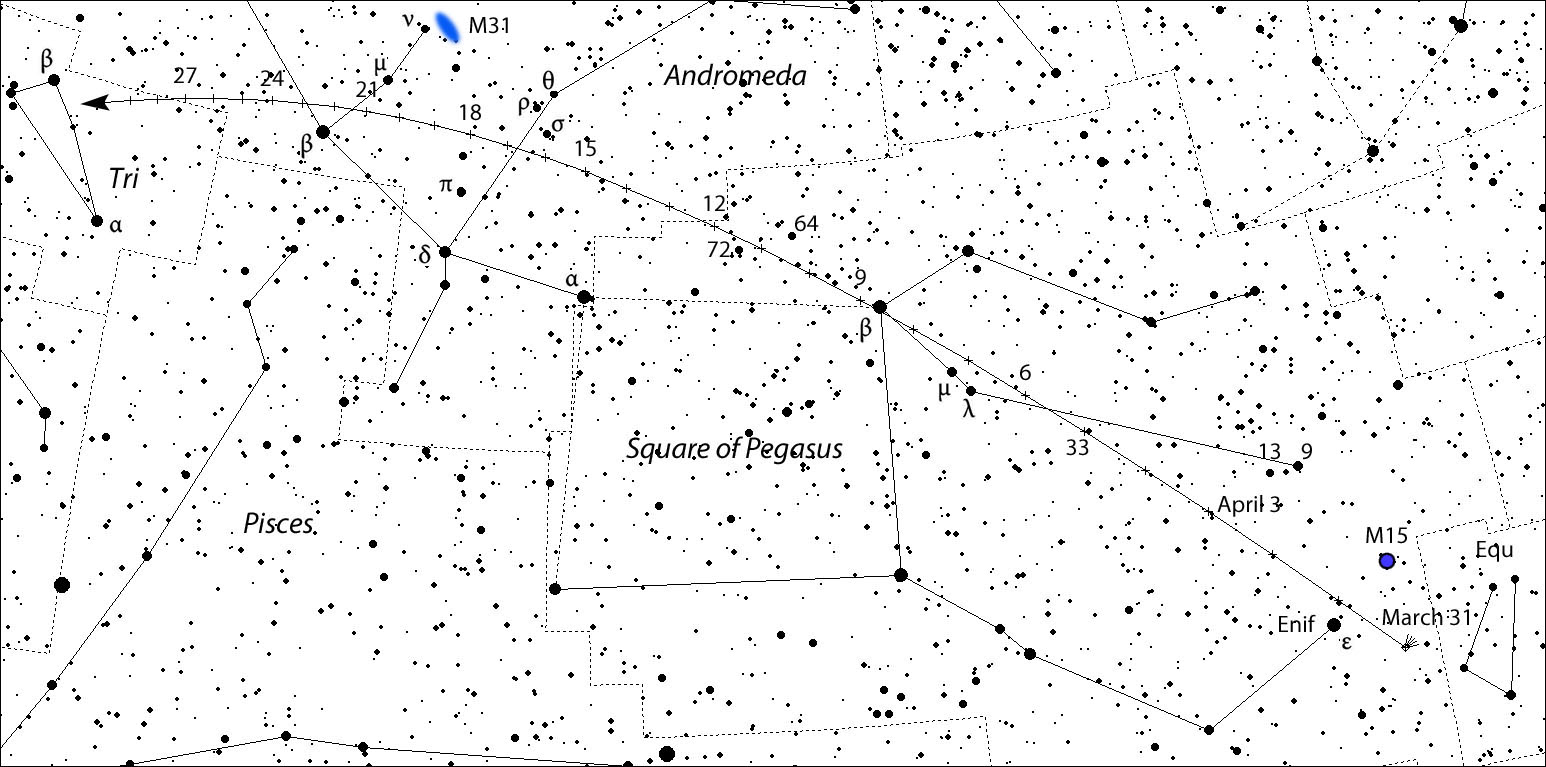
Map: Bob King, Source: Chris Marriott's SkyMap
The Stellarium map shows the comet's position on April 1st before dawn. I include it so you can see the "lay of the sky" at dawn to anticipate what to look for. The more detailed map shows the comet's position every three days with the standard north up orientation.
Please feel free to share your observation at the Comments link. What you see will help others know what to anticipate. I'm grateful to New Zealand sky enthusiast Graham Wolf for his unflagging reporting on the comet, part of the reason I got up at 5 a.m. to see it! There's ongoing discussion among comet observers that C/2017 E4 may be intrinsically faint and soon fade or disintegrate before perihelion — all the more reason to have a look while the looking's good.
To stay abreast of new developments with Comet E4 Lovejoy, join the Comets Mailing List for current images and commentary.
 20
20









Comments
Ernie Ostuno
March 30, 2017 at 1:27 pm
Thanks, Bob...really appreciate fast-breaking news like this about comets and novae/supernovae. I saw 41P/Tuttle/Giacobini/Kresak around 03 UTC 3/29 and guesstimated a brightness of 6.8 to 7.0. The nice thing about that one is it is circumpolar and visible all night long from 40N. If we ever get clear weather again I will have to get up early for this one. Mr. Lovejoy seems to be one of the few people these days beating the robots to discover comets.
You must be logged in to post a comment.
Bob KingPost Author
March 30, 2017 at 2:51 pm
Beating the robots, indeed! How true. Clear skies are forecast for my region tomorrow morning, so I'll be out looking, too. Good luck to you, Ernie.
You must be logged in to post a comment.
Ernie Ostuno
April 1, 2017 at 9:29 pm
Well, it cleared out and I tried seeing Lovejoy from my suburban backyard with 10x50 binoculars around 0945 UTC 4/1. I was able to pick up the nearby M15 but the comet's surface brightness was too low and I could not see it. I also failed to get 41P. These two comets are low surface brightness objects and may not be visible from "average" skies with binoculars...and I am not quite motivated enough to drag the scope out on a frosty April morning. Back in the day maybe...
You must be logged in to post a comment.
Bob KingPost Author
April 2, 2017 at 10:41 am
Hi Ernie,
You may have just hit an unlucky moment. The comet now appears to be fading. At least temporarily. Latest observations indicate it's closer to mag. 8 when just a couple days ago it was mag. 7.3. 41P should have been visible since it's still around mag. 7 and high in the north. I saw it two nights ago in a moonless sky and it was pretty easy though - as you pointed out - diffuse. UPDATE: On April 2-3 the comet appears to have brightened again, especially its tail.
You must be logged in to post a comment.
March 30, 2017 at 1:35 pm
I saw Comet 41P last night(3/29) with my Meade 130mm reflector at 43x. A shooting star also zipped through my field of view as I was looking at it. I may try this one, too.I'd love to see a really bright one come by.
You must be logged in to post a comment.
Bob KingPost Author
March 30, 2017 at 2:52 pm
AlphaCen,
Lovejoy should be most interesting to watch trot along through Pegasus the next week. Will it brighten further? Or?
You must be logged in to post a comment.
Graham-Wolf
March 31, 2017 at 12:04 am
Hi Bob
Awesome report.. love the latest photos and charts.
I heartily echo your latest sentiments. re C/2017E4 Lovejoy.
Wow... It's really brightened up these last 2 days or so!
No problem in 10x50s, and a faint tail 0.2 to 0.3 deg long (to ~ 12th Mv) in PA 270 to 280 deg these last two days, with the 12cm f4 GOTO at 50x .
But... it gets even better!
Mv 7.4 just 2 days ago, and Mv 7.1 this morning in my trusty 12cm f4 GOTO Newtonian at 50x (I even got a Sidgewick estimate of 7.0 in my 10x50 B's). That is just awesome.... the comet's seemingly gone to "turbo-boost" visually. Between Goiato, Mattiazzo, Gonzalez, and myself (amongst several orthers out there), that comet is getting almost round-the-clock attention. I think it just might steal the limelight from 41p/ T-G-K.
This morning, the skies cleared for an hour or so centred on 3:30am. Yesterday , my night skies in the Antipodes stayed clear all night... then thick fog rolled in around 4:30am. BUT... got the comet BOTH times!
Terry sure knows how to find winning comets, doesn't he?
So... get those Binocs out of the cupboard, go outside and "nail" Comet Lovejoy, whilst it's running hot.
Astro-Bob has gone and turned on the comet's after-burner switch.
It may fizzle out in a few weeks.... there's no time like the present.
ENJOY!
And thanks, Bob, for the personal attribution.
I think we have both given the wider public, a really good dose of Comet Lovejoy fever.
Let's hope it's infectious!
Regards from 46 South, NZ. Graham W. Wolf
You must be logged in to post a comment.
Bob KingPost Author
March 31, 2017 at 12:10 am
Graham,
Thanks for continuing to stoke the comet fires! I'll be out tomorrow morning for a look at Lovejoy with the 15-inch (37-cm) reflector. Can't wait.
You must be logged in to post a comment.
Graham-Wolf
March 31, 2017 at 12:15 am
Awesome wide angle photo, you've taken of Comet Lovejoy, Bob.
Impressed!
Regards from 46 South, NZ. Graham W. Wolf
You must be logged in to post a comment.
Graham-Wolf
March 31, 2017 at 1:46 am
Mmmm Bob.
If I do get a clear sky ~ 6 - 6:30am NZDT tomorrow, I should get to see 2017E4 Lovejoy with 10x50's just a few scant degrees below Enif in Pegasus ( a great stellar aiming point). Meanwhile, Bob, you'll be aiming slightly above Enif. On April 8th and 9th, it'll be almost right over Beta Peg. The Moon's nicely out of the way for a while, so no excuses. Let's see if it can get to naked eye. You'll need a 7.0 or better sky to do it. Let's try!
Regards from 46 South, NZ. Graham W. Wolf.
You must be logged in to post a comment.
March 31, 2017 at 9:30 am
The 'PACA Comets Lovejoy Group' link gives me a 'content not available' error Bob.
You must be logged in to post a comment.
Bob KingPost Author
March 31, 2017 at 10:12 am
Hi goodricke1,
Thanks for pointing that out. I re-did the link and tested it and it works. If it breaks for some reason or doesn't work for you, please let me know.
You must be logged in to post a comment.
March 31, 2017 at 5:43 pm
Thanks for checking Bob; I do have a facebook account but get 'The link you followed may have expired, or the page may only be visible to an audience you're not in.' So it might be a closed group, but thats ok.
You must be logged in to post a comment.
Bob KingPost Author
March 31, 2017 at 5:47 pm
Goodricke1,
It must be a closed group. Instead, join the Comets Mailing List for current observations of Lovejoy and other comets at: https://groups.yahoo.com/neo/groups/comets-ml/info
You must be logged in to post a comment.
March 31, 2017 at 10:57 am
Great article! I saw the comet this morning at about 5:00 AM. It showed a compact blue-grey glow at 63X, and a fairly large, diffuse coma at 250X. A jet was visible, roughly facing South. This comet is like the last Lovejoy, getting brighter than expected!
You must be logged in to post a comment.
Bob KingPost Author
March 31, 2017 at 3:29 pm
Thanks W.Coast astro! I thought it appeared just a little bit fainter this morning than on Weds. March 29. Through the telescope, it looked fantastic. Very obvious blue-green color, flattened coma and very faint tail. If only it were a little higher before dawn started!
You must be logged in to post a comment.
SNH
April 4, 2017 at 4:19 pm
Hey Bob,
After observing the supernova on April 1st, I also got to see the four morning comets in 7x35 binoculars – with three of them being my first time ever seeing them! Comet T-G-K was about +6.5 and still naked eye while the second brightest of the night was Lovejoy at about +7.3 (and a very easy binocular target – looked like a globular cluster one magnitude dimmer than nearby M15). High overhead was comet Johnson at about +8.0 (and distinctly visible in the 7x35s) while the hardest to catch in the 7x35s was PanSTARRS (just glimpsed it) at about +8.5 and only 20° up. I hope more people try and catch all four in the coming days before the Moon interferes.
I’m simply amazed at how far out some of these comets are discovered (in 2015 for Johnson and PanSTARRS) while I just saw a “super bright” binocular comet, Lovejoy, that had only been discovered 22 days before!! That’s incredible. I can’t wait to see how bright Lovejoy inevitably gets. Will have to let you know when I see it for first time naked eye!
Awesome article,
Scott
You must be logged in to post a comment.
Bob KingPost Author
April 4, 2017 at 8:26 pm
Four binocular comets in one night - wow! Very cool. Thanks again for sharing your observations SNH. ER61 PANSTARRS just underwent an outburst and is now around magnitude +7.5. Definitely worth observing again. While low from my latitude, it's up before dawn, so I'll be trying to get my first look at it.
You must be logged in to post a comment.
Graham-Wolf
April 5, 2017 at 2:18 am
Hello Bob.
Back in action, after a few days of lousy weather!
My latest visual data.... Comet Lovejoy's still brightening!
It's also headed for Solar Conjunction in the next few days.... we won't see it for a while...
C/2017E4 LOVEJOY
Apr 02.742 UT Mv 7.0 5 arcmin coma DC6 10x50B
02.745 UT Mv 7.2 6.2 arcmin coma DC6 12cm f4 L at 50x
03.742 UT Mv 6.6 5 arcmin coma DC7 10x50B
03.746 UT Mv 6.8 5.6 arcmin coma DC6 12cm f4 L at 50x
04.742 UT Mv 6.2 6 arcmin coma DC7 10x50B
04.746 UT Mv 6.4 6.8 arcmin coma DC6 12cm f4 L at 50x
AAVSO-VSP Comparisons:- 15df Mlim 8 centred on Enif, in Pegasus.
Loejoy now really too far North to see from 46 South... now way can I see the Andromeda Galaxy before and even during dawn onset, which is now, today, right on 6am NZST.... 18h UT.
Also, Bob,
C/2015 ER61 PANSTARRS has also gone into another outburst.
My data below...
APR 02.729 UT Mv 8.4 6.5 arcmin coma DC5 24 arcmin tail in PA 260 to ~ Mv12.
03.729 UT Mv 8.0 6.3 arcmin coma DC5
04.719 UT Mv 7.2 4.8 arcmin coma DC6 20 arcmin coma in PA 260 to ~ Mv 12
All obs with 12cm f4 L at 50x
AAVSO-VSP comparisons 7df MLim 12 centred on Beta Cap.
Cyclone DEBBIE which trashed Queensland the other day, has crossed the Tasman and started trashing central NZ. Down here in the Deep South, we'll probably get some tonight. Battening down the hatches, rivers are on the rise, as are also local wind speeds! We'll come through it OK, us tough "Kiwis".
FYI
The first naked eye observation of Lovejoy can't be further away... so go to it, you "Northerners!
Regards from 46 South, NZ. Graham W. Wolf.
You must be logged in to post a comment.
Bob KingPost Author
April 5, 2017 at 2:14 pm
Hi Graham,
I saw ER61 today - couldn't believe it. Easy in binoculars even though only 7 degrees high. Nice in the 10-inch scope with a faint, broad tail. What an outburst! I wanted to ask you if you submit your data to the COBS database (http://www.cobs.si/) or LIADA (https://rastreadoresdecometas.wordpress.com/)? If you don't, you should 🙂
You must be logged in to post a comment.
You must be logged in to post a comment.